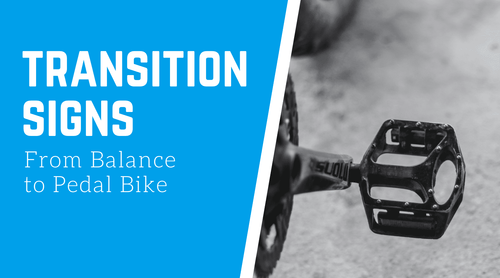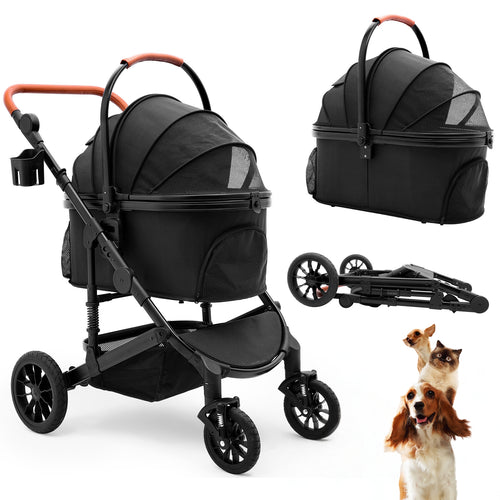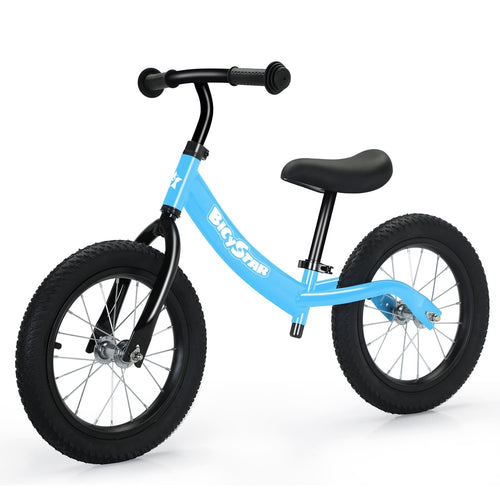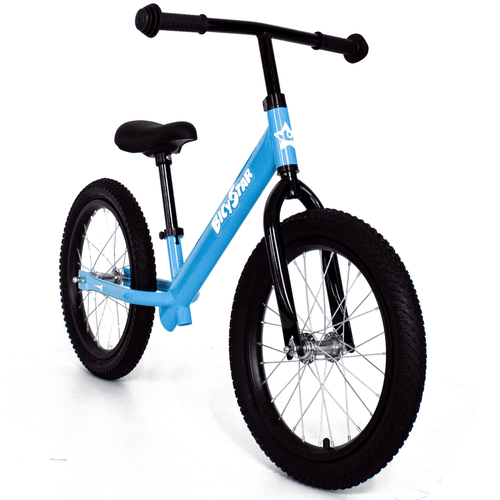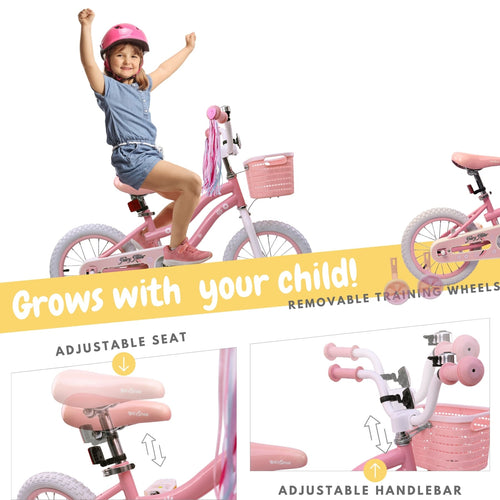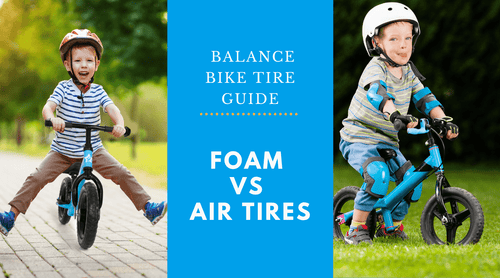Introduction: Is Your Little One Ready for a Pedal Bike Adventure?
When you first placed your hands on the handles of a balance bike, your eyes wide with cautious excitement, you kickstarted a journey. This bike, simple and devoid of pedals, became the vessel through which your child discovered the joys of movement, the freedom of speeding down pathways, and the fundamental skills of balance. But as with all beginnings, there comes a time to move forward, and for your little rider, this means transitioning from a balance bike to a pedal bike.
Welcome to an exhilarating developmental milestone—a time filled with anticipation, growth, and perhaps a few scraped knees, but above all, burgeoning independence. It can be bittersweet to watch your child prepare to leave behind their first two-wheeled friend, ready to conquer one with pedals. But how do you know they're ready? And once you're certain, how can you ensure this evolution in their biking journey is as smooth as a well-oiled chain?

Choosing the right moment for this transition is less about age and more about recognizing your child's comfort and skill level. It's about noticing when their feet skim the ground less and their confidence soars higher—when they start asking questions about bikes with pedals and eye the bigger wheels with a spark of curiosity.
In this post, we'll cover the terrain of this transition comprehensively. From the "look out for" skills that showcase readiness, to the emotional resilience it might require from your child (and let's be honest, from you too), and the practical tips to make the switch as successful as their first triumphant balance bike glide.
As a dedicated kids bike expert and fellow parent, I understand the urge to capture each moment before it slips through your fingers. But in the world of biking, like in life, we look to the horizon and pedal towards new chapters. So, let's saddle up and explore whether your child is poised to tackle the thrilling ride ahead on a pedal bike.
Understanding the Balance Bike Basics
The balance bike: a brilliantly simple concept with a monumental purpose in your child's cycling journey. This pedal-less wonder isn’t just a toy; it's a learning apparatus, engineered to enhance motor skills, coordination, and, most crucially, balance. Watching your little one stride along, feet lifted, whizzing by with a look of pure joy, what they're actually doing is learning how to balance and laying the groundwork for all future two-wheeled endeavors.
Balance bikes are designed with a child's anatomy and capabilities in mind. They enable young riders to sit on the bike seat and easily touch the ground with their feet, providing stability as they push off and glide. This design encourages youngsters to learn steering and balancing naturally—skills critical when transitioning to pedal bikes. Unlike traditional bikes with training wheels, balance bikes require children to maintain their equilibrium, promoting better posture and coordination, which are key when they eventually progress to bikes with pedals.

Here's a bit of context to illustrate the point: when children roll along on balance bikes, they're learning to shift their weight and intuitively direct the handlebar to navigate turns, just as they will need to on a pedal bike. They also learn spatial awareness and speed control without the crutch of training wheels, which means they could make a smoother transition to a bike with pedals, often bypassing the false security that training wheels provide. This mastery of balance and control is why children who start on balance bikes typically find the move to pedal bikes not just manageable but exciting.
But before you rush out to scout for a new bike with pedals, pause and reflect on the strides your child has made on their balance bike. Are they lifting their feet confidently, cruising for considerable lengths without needing to stabilize themselves? Have they laughed in the face of little tumbles and hopped back on with renewed determination? These are early chapters of a story about to unfold into a venture where balance meets the pedal, an invaluable saga in the making. Keep these foundational experiences in mind as we prepare to shift gears, understanding when and why your child is ready to pedal bike.
When to Consider the Transition from Balance Bike to Pedal Bike
The transition from training wheels to actual bicycling is a time-stamped memory for many of us. But for our children, who begin on balance bikes, that iconic biking rite of passage is upgraded. They experience an evolution from 'balancing' to 'pedaling,' a change that's equally memorable. While there's no universal timeline that dictates when to make this shift, there are key indicators that will signal you both that the time is ripe.
First, observe your child’s physical readiness. Can they glide on their balance bike for long distances without their feet touching the ground? This skill signifies strong balancing abilities and is a solid foundation for pedaling a bike. They should be able to maneuver around obstacles easily, control the bike’s speed with a hand brake, and come to a balanced stop. These abilities show that they have full command over their balance and steering—critical cues when considering their readiness.

Another crucial aspect is their size. As your child grows, they may outgrow their balance bike, indicated by knees hitting the handlebar or their body towering over the bike frame awkwardly during rides. Bikes come with size recommendations which often include age and inseam measurements—so if your child is stretching the limits of their balance bike's capacity, it may be time to start looking at a pedal bike that better suits their proportions.
But physical ability isn't the sole measure—there's also enthusiasm to gauge. Is your little one showing curiosity about bikes with pedals? Are they watching older kids or siblings pedal with keen interest? This display of eagerness is a significant factor. Your child’s intrinsic motivation can fuel their transition and ease the learning curve that comes with mastering pedal bike riding.
Key indicators for readiness also lie in their proficiency with the balance bike—look beyond mere riding. When they're performing more advanced maneuvers like hopping off curbs or standing on the pedals to coast down gentle slopes, they're showcasing agility that’s well-suited for pedal bikes.
It’s important, though, not to rush this milestone. Children bloom on their schedules, some sprouting quickly, others taking their time to absorb each phase. Pressure to advance prematurely could lead to frustration or, worse, a regression in confidence. Wait for these signs that they're ready, and when you spot them, pencil in time for the big transition: the day when balance meets pedal, and your child pedals forward, figuratively and literally, into a new chapter of their biking adventure.
Skills to Look for in Your Balance Bike Rider
Now that we've established the ‘when’ behind the transition, it's equally important to understand the ‘what’—what specific skills should your child showcase on their child’s balance bike before moving on to a bike with pedals? The transition from a balance bike entails more than just an ability to sit and move on two wheels; it involves a set of refined motor skills and a certain level of instinctual cycling savvy.

The first and most obvious skill is balance—specifically, the ability to glide with feet up for at least a few seconds. This skill demonstrates control over the bike and an understanding of the delicate dance between a rider's body and the bike's motion. Watch for consistent and long glides, indicating that your child has developed a sense of equilibrium and centripetal force, allowing them to ride without support.
The next skill to watch for is steering precision. If your little one can navigate their balance bike around obstacles, corner with ease, and dodge sudden barriers in their path, they have the necessary steering control for a pedal bike. This mastery over direction changes without losing balance is crucial when adding the complexity of pedaling into the mix.
Braking is another fundamental skill that your child must get a handle on. If they’re using their balance bike’s hand brake to slow down and stop effectively, rather than dragging their feet on the ground, they're demonstrating an understanding of bike mechanics and safety. This is a skill learned from riding a balance bike that directly transfers to pedaling a bike, where control over speed becomes crucial.
But what about the physical actions involved in pedaling? How has riding a balance bike prepared them for this step? Perhaps paradoxically, even without pedals, a balance bike can prepare your child for this motion. Are they showing interest in how bikes move, asking about pedals, or even mimicking the pedaling motion with their feet while gliding? These could be signs that your child is ready to make the transition.

It's also important to note the child’s confidence levels. You want to see a child who exhibits fearless enthusiasm for their balance bike, one who is willing to challenge themselves with little prompting. A confident child will more readily adapt to the changes a pedal bike will introduce because they've already embraced the sensation of speed and independence on their balance bike.
Remember, the transition from balance bike to pedal bike isn't about meeting a checklist of skills in a rush. Allow your child the luxury of progressing at their own pace, mastering each skill thoroughly and with joy. Their readiness to move from riding a balance bike to a pedal one isn't a race to the pedal finish line but a collection of experiences that, when put together, will naturally unfold into the next stage of biking—all in good time.
Selecting the Right Pedal Bike
The day has come: your child has mastered the balance bike, and you're about to venture into the world of pedal bikes. But wait, before you rush out the door, let's talk about picking the right first pedal bike. The transition to a pedal bike is not just about moving on to a bigger bike; it's about finding the right fit that aligns with your child's skills and stature to provide the most positive and confident riding experience.

First up, size matters when your child is learning to ride a bike, starting from the balance one to transitioning to a pedal one. A pedal bike's size is typically measured by wheel diameter—12″, 14″, or 16″ for the youngest riders. When selecting the next bike, the aim is not for your child to 'grow into' it, but for them to ride it comfortably right now. That means ensuring the minimum seat height allows your child to sit on the saddle with both feet flat on the ground. This provides stability and confidence as they learn the new skill of pedaling. The bike’s weight also plays a pivotal role; it should be manageable for your child to handle, encouraging autonomy and preventing it from becoming a discouragement if they topple over.
Then consider the geometry of the bike. Does the handlebar position allow for upright and comfortable posture? Ergonomic design facilitates better control, especially when transitioning from a balance bike that likely had a similar rider-friendly setup. Also, look for models with a hand brake similar to their balance bike. This continuity helps leverage existing skills and makes the learning process seamless, while also teaching your child about conventional bike safety features.
Choices abound when it’s time to pick the bike and pedals, and it's easy to be swayed by eye-catching designs or what's popular in the neighborhood. But functionality should take precedence. Consider bikes with removable training wheels, which can be useful in the initial phase if needed. However, since your child is transitioning from a balance bike, they might bypass the need for training wheels altogether, as they've already developed strong balancing skills.

Lastly, test the waters. If possible, let your child try out a few different sizes and styles of pedal bikes. It's essential they feel comfortable and secure because the more they enjoy riding the bike, the more they will ride, reinforcing their new pedaling skills and boosting their overall development and fitness.
In summary, when it comes to transitioning to pedal, a wise selection can be the difference between a child who hesitates and one who pedals ahead with confidence. You're not just choosing a new bike; you're picking a tool that'll further shape your child's cycling journey — where learning to balance becomes learning to ride.
Preparing for Tears and Tantrums: Emotional Readiness
Embarking on the transition to a pedal bike is not solely a physical milestone but an emotional one too. Mastering a balance bike might have seemed like a large hurdle, but introducing pedals can bring about a new wave of challenges—and potentially, a few tears and tantrums. It's a natural part of the learning process, and being prepared for it can make all the difference in how your child perceives and overcomes these hurdles.

Anticipate the wobbles and falls. No matter how adept your child has become on their balance bike, the pedal bike introduces a new element that can affect stability. Understand that the first few attempts may not go smoothly and reassure your child that it’s perfectly okay. It’s essential to remain patient and provide plenty of encouragement. Positivity from you can help transform frustrations into determination and keep the learning atmosphere light and fun.
Managing expectations is also key. Your child may think that since they were a star on their balance bike, pedaling should come naturally, but this isn't always the case. It's critical to explain that learning to pedal is a new skill and may take some time to master. Offering a perspective on the learning process as a series of small, achievable goals can help keep your little rider motivated and less likely to get upset.
Emotional readiness also ties into your child's resilience. Have they learned to bounce back from minor scrapes or setbacks on their balance bike? Resilience is a muscle, quite literally and figuratively, that your child has been building up—one that will serve them well when tackling pedal bike riding.
It can be helpful to share stories or videos of other children learning to ride pedal bikes, including the wobbles and the eventual success. Seeing peers undergoing the same challenges can normalize the experience for your child, helping them understand that they are not alone in their struggles.

Remember, riding a pedal bike involves coordination and timing—skills that require practice and patience to hone. As you support your child through this transition, celebrate the small victories along the way. Each push of the pedal, each stretch of a ride without your steadying hand, and each recovery from a tumble are foundational building blocks that pave the road to independent riding.
And when the inevitable happens—a resistance to try again after a fall or frustration sets in—it's important to recognize when to take a break. Sometimes a short diversion or a change of activity provides the necessary breather that allows both of you to return to the task with renewed energy.
So embrace the emotional journey with as much preparedness as the physical one, knowing that each tear wiped away and each tantrum weathered is a stepping stone towards your child's growth and joy in cycling. With your support, they'll soon be pedaling away, a broad grin replacing any sign of earlier upset.
The Actual Transition: Tips to Make the Shift Smooth
Moving from balancing to pedaling is a significant stride in your little biker's life. Like any transition, it can come with its bumps in the road—but with the right approach, it can be as exhilarating as that first successful solo glide. Here’s how you can oil the gears of this major cycling milestone to ensure a smooth ride for your child.
Start with a proper introduction to the pedal bike. Before jumping right into riding, allow your child to become familiar with their new bike. Let them walk it around, sit on it to get a feel of the seat height and the position of the pedals. It’s akin to making a new friend; you want your child to feel comfortable and gain an initial level of trust with their new bike.

Easing into the use of pedals can be achieved by taking the pedals off initially, transforming the new bike into a pseudo-balance bike. This step allows your child to focus on the feel of a bigger, heavier bike without the complexity of pedaling. They can use their feet to propel themselves as they did on their balance bike, and once they are comfortable, the pedals can be reattached.
When it's time to introduce the pedals, position your child’s feet on them and gently guide the bike forward, helping them understand the motion required. Make sure to communicate that they may need to push harder than they’re used to with the balance bike to get the pedal bike moving. Hand-holding is sometimes not just metaphorical in this phase—it's practical. Walking or jogging alongside your rider, providing stability, and offering guidance can prevent falls and build confidence.
Practice in a safe, open environment, like a flat, grassy park, which can provide a soft landing for any potential falls and give your child ample room to maneuver without the fear of traffic or too many obstacles. Keep sessions short and sweet; fatigue can lead to frustration, so it's essential to watch for signs that your child has had enough for the day.
Positive reinforcement goes a long way during this transition. Celebrate the small successes, whether it's pedaling a short distance on their 14 Your encouragement will serve as wind beneath their pedals, giving them the motivation to keep going.
And while this may seem counterintuitive, don’t be afraid to step back. Once your child starts to get the hang of it, let them try it out without any intervention. Your watchful eye will always be there, but their skills need to take the spotlight.
This transition period is pure gold—fleeting and full of 'firsts.' Remember to capture these memories, be it through photos, notes, or simply mental snapshots. These are the moments that you'll both look back on with pride and joy.
Implementing these tips will not only promote a successful transition to pedal but will also continue to nurture your child's love for cycling. It's not just about learning a new way to move—it's about embarking on new adventures. Riding a bike is one of the ultimate expressions of freedom for a child, and you’re helping to unlock that world for them. Keep pedaling forward together, one push at a time.
Should You Keep the Balance Bike?
As your child becomes more comfortable and proficient on their pedal bike, a question may roll into your mind: what do you do with the balance bike that's been so foundational to their learning? The quick response might be to pass it on or sell it, but there are several compelling reasons to consider keeping it around for a little while longer.
For starters, the balance bike can continue to be a source of fun and exercise for your child, especially on days when they're not up for the challenge of a pedal bike. It can serve as a low-pressure option for casual riding, offering a familiar comfort and reinforcing the balancing skills that are still developing.
Moreover, having the balance bike available can be beneficial if your child encounters a setback or sudden reluctance with their pedal bike. It can serve as a reassuring fallback option, allowing them to regain confidence and enjoyment in riding at their own pace, without the pressure of pedals.

In multi-child households, the balance bike may naturally fall into the younger sibling's hands, serving as an heirloom of sorts, brimming with sentimental value and ready to start the learning journey anew. But what if your pedal biker is an only child or the youngest of the bunch? In these situations, consider the community around you as your child makes the transition from a balance bike to a 14 Perhaps there's an opportunity for sharing or lending the balance bike within your neighborhood, friends, or family, fostering a spirit of generosity and extending the bike's life of service.
There's also the practical side of things. Make sure that when you transition to a pedal bike, you don't simultaneously introduce too many new challenges, such as a substantially larger size or weight that can overwhelm your child. In this case, your child might not be finished with the balance bike yet, as it can be used to smooth the learning curve.
In the end, the decision to keep the balance bike should be weighed against your family's specific needs, your child's attachment to it, and the practicalities of space and usage. If you do choose to say goodbye to the balance bike, ensure it's a joyous occasion; celebrate the growth it facilitated and the adventures it supported before passing on the torch.
Whichever path you choose for your child's first set of wheels, remember that the essence of what they represent—a child's independence and joy in riding—will always stay with the rider, not the bike. So, whether the balance bike stays or goes, the thrill of those early glides will persist, ingrained in the pedal strokes of your child's biking future.
Embrace the Journey from Balance to Pedal
As our cycling tale approaches its poignant conclusion, we can look back on the trail we've navigated—from the first tentative pushes on a balance bike to the triumphant strides of pedaling independently. The journey your child undertakes from balance to pedal bike is much more than a set of wheels—it's a rite of passage, a developmental milestone, and an adventure into newfound freedom.
Here’s a quick recap to keep these important navigational aids in your parenting toolkit:
- Balance prowess: Gliding with feet up and mastering the stop-and-go are sure signs your child is ready to transition.
- Steering skills: Agile maneuvers around the garden gnome or the living room chair show developing mastery.
- Braking basics: Graduating from foot dragging to hand braking is a big step towards a real bike.
- Sizing up: Ensure your child can touch the ground with their feet when seated on the new pedal bike for a safe transition.
- Emotional readiness: Be prepared for wobbles of the bike and the heart—patience and encouragement are your best tools.
- Practice makes pedal-perfect: Short, positive sessions in safe environments build skills and confidence.
- Sometimes less is more: Taking the pedals off the new bike initially can make the learning curve less steep.
As the chapter on balance bike fades, your child pedals into a new world—one where each ride is an opportunity for discovery and each new challenge is a chance to grow. They’ll forge their path with every determined pedal push, carrying forward not just the skills they've learned, but also the confidence and independence they've gained.
So, roll forward with enthusiasm on this parenting adventure, subscribe for more insights and anecdotes, and always remember: the best family memories often include bike trails, laughter, and the great outdoors. Are you ready to embrace the pedal path ahead? Let’s ride this journey together—one pedal stroke at a time.

